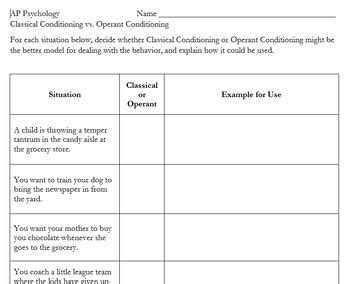Operant Conditioning Versus Classical Conditioning

Operant conditioning and classical conditioning are two fundamental concepts in the field of psychology, particularly in the realm of learning theory. These concepts, developed by renowned psychologists B.F. Skinner and Ivan Pavlov, respectively, have been extensively studied and applied in various contexts to understand human and animal behavior. The distinction between operant and classical conditioning lies in their underlying mechanisms, applications, and the types of behaviors they aim to explain. In this article, we will delve into the principles of both conditioning types, explore their differences, and discuss the implications of each for our understanding of behavioral processes.
Introduction to Classical Conditioning

Classical conditioning, as introduced by Ivan Pavlov, involves the association of an initially neutral stimulus with a stimulus that naturally elicits a response. Pavlov’s seminal work with dogs, where he paired the sound of a bell (a neutral stimulus) with the presentation of food (an unconditioned stimulus), led to the observation that over time, the sound of the bell alone could elicit salivation (a conditioned response), which was originally elicited only by the food. This process illustrates how organisms can learn to associate stimuli and respond to them in predictable ways, highlighting the role of environment in shaping innate behaviors.
Key Components of Classical Conditioning
The process of classical conditioning involves several key components, including the unconditioned stimulus (US), the unconditioned response (UR), the conditioned stimulus (CS), and the conditioned response (CR). The unconditioned stimulus is a stimulus that naturally and automatically triggers a response without any prior learning, such as food triggering salivation. The unconditioned response is the unlearned, naturally occurring response to the unconditioned stimulus, such as salivation when food is presented. The conditioned stimulus is a previously neutral stimulus that, after becoming associated with the unconditioned stimulus, eventually comes to trigger a conditioned response, such as the sound of a bell. The conditioned response is the learned response to the previously neutral stimulus, which occurs after the conditioning process, such as salivating when hearing the bell.
| Component | Description |
|---|---|
| Unconditioned Stimulus (US) | A stimulus that naturally elicits a response. |
| Unconditioned Response (UR) | The natural, unlearned response to the US. |
| Conditioned Stimulus (CS) | A neutral stimulus that becomes associated with the US. |
| Conditioned Response (CR) | The learned response to the CS. |

Introduction to Operant Conditioning

Operant conditioning, developed by B.F. Skinner, focuses on the modification of behavior through its consequences, such as rewards or punishments. Unlike classical conditioning, which deals with the association of stimuli to elicit responses, operant conditioning explores how behavior is controlled by its outcomes. Skinner’s work with the operant conditioning chamber, or “Skinner box,” demonstrated how behaviors could be increased or decreased based on the consequences that followed them. For example, if a rat receives a food pellet every time it presses a lever, the behavior of pressing the lever is likely to increase.
Key Components of Operant Conditioning
Operant conditioning involves several key components, including positive reinforcement, negative reinforcement, punishment, and extinction. Positive reinforcement occurs when a behavior is followed by the presentation of a pleasing or desirable stimulus, such as a reward, which makes that behavior more likely to happen in the future. Negative reinforcement involves the removal of an unpleasant or aversive stimulus as a consequence of behavior, which also increases the likelihood of the behavior occurring again. Punishment is the application of an aversive stimulus or the removal of a pleasing stimulus following a behavior, which decreases the likelihood of the behavior happening again. Extinction occurs when a behavior that was previously reinforced is no longer reinforced, leading to a decrease in the behavior over time.
Key Points
- Classical conditioning involves the association of stimuli to elicit responses.
- Operant conditioning focuses on the modification of behavior through its consequences.
- Both types of conditioning play crucial roles in understanding learning and behavioral processes.
- Classical conditioning explains automatic responses to stimuli, while operant conditioning addresses voluntary behaviors influenced by their outcomes.
- Understanding these conditioning types is essential for developing strategies in education, psychology, and behavioral modification.
The distinction between classical and operant conditioning highlights the complexity of behavioral processes and the various mechanisms through which learning and adaptation occur. By recognizing the differences and applications of these conditioning types, researchers and practitioners can develop more effective strategies for behavioral modification, education, and therapy, ultimately enhancing our understanding of human and animal behavior.
What is the primary difference between classical and operant conditioning?
+The primary difference lies in their focus: classical conditioning deals with the association of stimuli to elicit responses, while operant conditioning focuses on the modification of behavior through its consequences.
Can both classical and operant conditioning be used for behavioral modification?
+Yes, both types of conditioning can be applied for behavioral modification. Classical conditioning can be used to associate stimuli with responses, and operant conditioning can be used to modify behaviors based on their consequences.
What are some real-world applications of classical and operant conditioning?
+Real-world applications include education (reinforcing desired behaviors), therapy (modifying maladaptive behaviors), and advertising (associating products with positive stimuli), among others.
In conclusion, operant conditioning and classical conditioning represent two fundamental approaches to understanding how behaviors are learned and modified. By grasping the principles of each, we can better comprehend the complex interplay between environment, behavior, and learning, ultimately informing strategies for education, behavioral modification, and therapeutic interventions.



